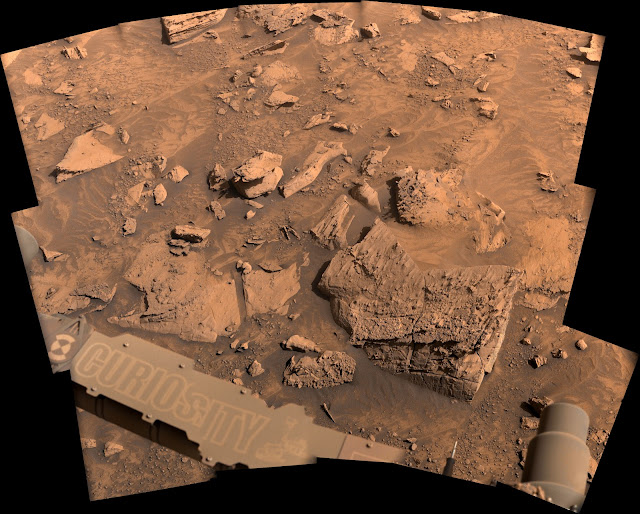Nuclear Electric Propulsion Technology: Making Mars Missions Faster | NASA
Modular Assembled Radiators for Nuclear Electric Propulsion Vehicles, or MARVL, aims to take a critical element of nuclear electric propulsion, its heat dissipation system, and divide it into smaller components that can be assembled robotically and autonomously in space. This is an artist’s rendering of what the fully assembled system might look like.
There are technologies that could help transport a crew on a round-trip journey in a relatively quick two years. One option NASA is exploring is nuclear electric propulsion. It employs a nuclear reactor to generate electricity that ionizes, or positively charges, and electrically accelerates gaseous propellants to provide thrust to a spacecraft.
Researchers at NASA’s Langley Research Center in Hampton, Virginia, are working on a system that could help bring nuclear electric propulsion one significant, technology-defining step closer to reality.
MARVL aims to take a critical element of nuclear electric propulsion, its heat dissipation system, and divide it into smaller components that can be assembled robotically and autonomously in space.
“By doing that, we eliminate trying to fit the whole system into one rocket fairing,” said Amanda Stark, a heat transfer engineer at NASA Langley and the principal investigator for MARVL. “In turn, that allows us to loosen up the design a little bit and really optimize it.”
Opening up the design is key, because as Stark mentioned, previous ideas called for fitting the entire nuclear electric radiator system under a rocket fairing, or nose cone that covers and protects a payload. Fully deployed, the heat dissipating radiator array would be roughly the size of a football field. You can imagine the challenge engineers would face in getting such a massive system folded up neatly inside the tip of a rocket.
The MARVL technology opens a world of possibilities. Rather than fitting the entire system into an existing rocket, this would allow researchers the flexibility to send pieces of the system to space in whatever way would make the most sense, and then having it all assembled off planet.
Once in space, robots could connect the nuclear electric propulsion system’s radiator panels where a liquid metal coolant, such as a sodium-potassium alloy, would flow.
While this is still an engineering challenge, it is exactly the kind of engineering challenge in-space-assembly experts at NASA's Langley Research Center in Hampton, Virginia have been working on for decades. The MARVL technology could mark a significant first milestone. Rather than being an add-on to an existing technology, the in-space assembly component will benefit and influence the design of the spacecraft it would support.
“Existing vehicles have not previously considered in-space assembly during the design process, so we have the opportunity here to say, ‘We’re going to build this vehicle in space. How do we do it? And what does the vehicle look like if we do that?’ I think it’s going to expand what we think of when it comes to nuclear propulsion,” said Julia Cline, a mentor for the project in NASA Langley’s Research Directorate, who led the center’s participation in the Nuclear Electric Propulsion tech maturation plan development as a precursor to MARVL. This tech maturation plan was run out of the agency’s Space Nuclear Propulsion project at NASA's Marshall Space Flight Center in Huntsville, Alabama.
NASA’s Space Technology Mission Directorate awarded the MARVL project through the Early Career Initiative, giving the team two years to advance the concept. Stark and her teammates are working with an external partner, Boyd Lancaster, Inc., to develop the thermal management system. The team also includes radiator design engineers from NASA’s Glenn Research Center in Cleveland and fluid engineers from NASA’s Kennedy Space Center in Florida. After two years, the team hopes to move the MARVL design to a small-scale ground demonstration.
The idea of robotically building a nuclear propulsion system in space is sparking imaginations.
“One of our mentors remarked, ‘This is why I wanted to work at NASA, for projects like this,’” said Stark, “which is awesome because I am so happy to be involved with it, and I feel the same way.”
Additional support for MARVL comes from the agency’s Space Nuclear Propulsion project. The project’s ongoing effort is maturing technologies for operations around the Moon and near-Earth exploration, deep space science missions, and human exploration using nuclear electric propulsion and nuclear thermal propulsion.
https://tfaws.nasa.gov/wp-content/uploads/TFAWS2024-ID-22.pdf
Article Credit: NASA Langley Research Center
Release Date: Jan. 10, 2025


IanInverarity.jpg)









Minnesota.jpg)
RD.jpg)












